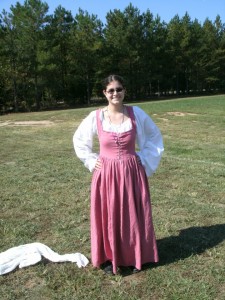 At friends’ urging, I ordered copies of Janet Arnold’s Patterns of Fashion 3
At friends’ urging, I ordered copies of Janet Arnold’s Patterns of Fashion 3 and Patterns of Fashion 4
and Patterns of Fashion 4 . Number 4 is “the underwear edition.” It’s full of shirts, chemises/smocks, coifs, ruffs, bands, drawers, partlets, etc. That arrived yesterday.
. Number 4 is “the underwear edition.” It’s full of shirts, chemises/smocks, coifs, ruffs, bands, drawers, partlets, etc. That arrived yesterday.
Page 54 shows on-grain hem tape at a neckline. Excellent!
Seam treatments in that book don’t show any seams bound the way I did, though a different type of bound seam is visible. It’s a flat strip sewn to the fabric on either side of the raw edges, with the raw edges hidden underneath. The example is out of period for the SCA, at 1659.
However, Patterns of Fashion 3 has, on page 43, photograph 309, what looks suspiciously like how I bound my seams (1585). So, I’m going with it, though in future I think I’ll use a more-obviously-correct seam treatment, like rolling a hem then sewing the pieces together.
Always research before you sew, kids.
Anyway.
I am now bounciful about the possibility of creating a smock based on what’s in that book. I also have a friend who requested a blackwork shirt when we were at Pennsic. He has agreed to the terms “I’ll make you a blackwork shirt, as long as I get to take my time on it and can enter it in an A&S competition.” So now I have an A&S To-Do List.
How to get very nice garb: challenge a seamstress.
I may need to talk to Lady Aaradyn about learning to make bobbin lace. Extant Italian smocks show little in the way of neck embroidery but lots of bobbin lace.


